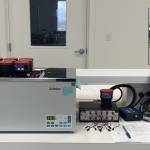In Vitro Gas Production Provides Insight into Equine Digestion

The equine gastrointestinal tract consists of two major regions: foregut and hindgut. The hindgut, consisting of the cecum and colon, is one of the most important parts of the gastrointestinal tract, as this is where fibrous material, the basis of the equine diet, is fermented by microbes or “little bugs.”
Microbial fermentation produces gas, heat, and volatile fatty acids. Volatile fatty acids are molecules from which horses obtain energy and are the primary source of energy for the maintenance activities of horses. Increasing the efficiency of fermentation in the hindgut results in more available energy to the horse from the fibrous components of its diet.
The hindgut microbiome can be easily disrupted by diet alterations, particularly high starch intakes from large amounts of grain. Therefore, it is important to understand the effect that certain dietary components can have on the hindgut’s fermentation properties.
The hindgut is, however, relatively inaccessible for research or diagnostic purposes, limiting understanding of the digestive processes that occur in this compartment. In horses, we can evaluate the digestibility of a feed by measuring how much the horse eats and how much it defecates, but what happens inside the horse is a black box.
In vitro gas production is a laboratory technique that aims to mimic the environment of the equine hindgut. The in vitro system gives researchers the ability to quantify the amount of fermentation that takes place by measuring total gas production, which is difficult to measure in the live horse. The more gas produced, the more microbial fermentation has taken place.
To carry out in vitro gas production research, fresh feces, a buffer, and a feed substrate are combined in the gas production bottles. Each bottle is then placed in a warm water bath. The feces contain the microbes and the buffer creates an ideal environment for the microbes to survive. The warm water bath retains an optimum temperature for the microbes of 38° C and rocks from side to side to imitate movement that occurs in the hindgut. The change in pressure in the bottles, indicating gas being produced, is automatically measured by the gas production system and sent to its computer software, allowing studies to run from hours to days without constant supervision.
From these studies, researchers gain information that would be difficult or impossible to obtain in a live horse. In a study involving soybean hulls and timothy hay, soybean hulls produced more total gas than timothy hay, indicating that it was fermented to a greater extent. However, the rate of gas production was greater for timothy hay during the first 20 hours of fermentation, indicating that timothy hay was fermented at a faster initial rate. If we had fed these two feeds to a horse to measure digestibility, researchers would only know the final digestibility value, or the extent of digestion, and know nothing about the rate of digestibility.
The in vitro gas production method also allows researchers to perform more experiments in a period of time, with larger sample size, or number of times a certain treatment is tested, compared to digestibility experiments in horses. A typical in vitro experiment runs for 48 hours, but a digestibility study using horses runs for 30 days.
Using this methodology, researchers can gather more information about how a particular feed ferments in the horse’s hindgut. They can look at feed additives or ingredients that might alter the ability of the microbes to ferment a certain feed before these products are ever fed to a horse. All of this information helps researchers make better decisions about how to feed horses.
This article was written by Alexa Arredondo Razo, Emily Robyn, and Iona Robinson, year-long interns at Kentucky Equine Research. As part of the intern program, participants are asked to contribute to Equinews occasionally. Learn more about the internship program.








